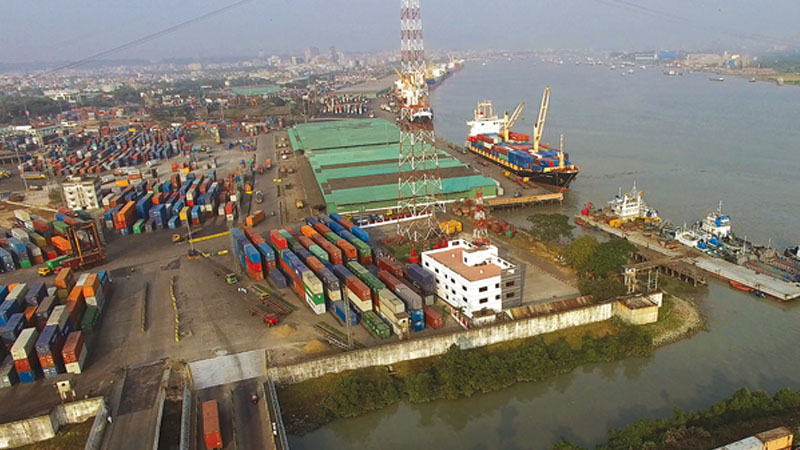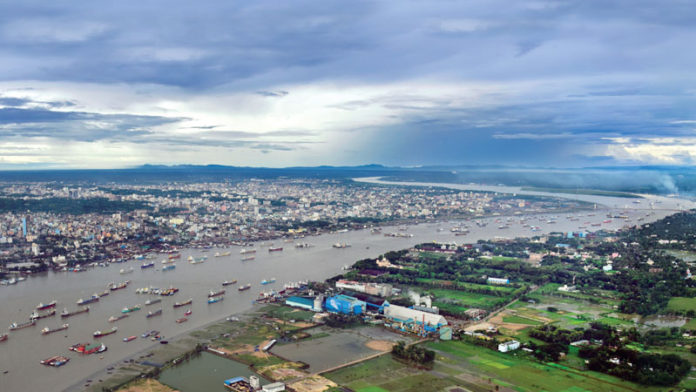Let me tell you the tale of a turbulent river. It started its journey in the Lushai mountains in Mizoram, like a fickleminded young woman it meandered its way to Bangladesh and took the name Karnaphuli.
‘What’s in a name?’
William Shakespeare
Rivers have wonderful names that contain their myths, their saga. The river Karnaphuli bears a story of its own as well. ‘Karnaphuli’ in Bengali means ‘concerning earrings’. It is said that the princess of Arakan was on a boat trip down the river. She stooped down to see the strong current of the river water and somehow her favourite earrings fell in the stream. Immediately she jumped in the water in the hope of rescuing her favourite jewels, but in vain. Her lover followed her to her destiny at the same time too. This tragic tale of lost earrings is entwined with the name of the river. Numerous folk songs and local rhymes ask the river Karnaphuli about the end of her journey since her days in Lushai mountains. Obviously, like any other rivers she ends it in the sea- in the bay of Bengal.
‘I have known rivers ancient as the world’
L Hughes
The alluvial delta that we call Bangladesh was made from the silt deposits of the Ganges, the Brahmaputra and the Meghna. The mountainous areas in Chittagong Hill tracts are topographically the only wide-ranging hilly area in Bangladesh. These hill tracts are about 2.5-3 million years old. Most possibly the river Karnaphuli dates back to that time as well. The array of rivers in the Chittagong hill tracts are different from the rest of the Ganga-Brahmaputra Delta. About 700 rivers criss-cross Bangladesh, most of them originating in mountains of India and Myanmar. These rivers are a wonderful source of freshwater and freshwater fish. They remain the main mode of transport in Bangladesh. Karnaphuli is in no way any exception.
‘And this is the tale that River told’
R Kipling
Chittagong comprises of Chittagong, Cox’s Bazaar, Bandarbans, Rangamati and Khagrachari. The longest flowing river in Chittagong is the Karnaphuli, about 275 km long. The tributaries originated in the wildest Mizoram with Karnaphuli are the Kasalang, Maini, Rangkhiyang and Chengi rivers. Starting its journey from the dark and deep wilderness of Mizoram, the Karnaphuli enters Chittagong hill tracts at Thegamukh as a river formerly called as ‘Thega’/ ‘Korpuilai’/ ‘Khawthlangtuipui’ river in Mizo language, and takes the name ‘Karnaphuli’. Meandering through the jungles and localities of the hill tracts on its way for 185 km, it flows into the Bay of Bengal. The average width of the Karnaphuli is about 667 metres (2118 feet) and the average depth near its estuary is about 8 metres. The river turned quite wide near its estuary, about 30 km away from Kalurghat. Every second the mighty river brings forth 260 cubic metres of water into the sea. Located near the estuary, stands the largest sea port of Bangladesh, ‘Port of Chittagong’.
The main tributaries of the river are Kasalang, Chengi and Halda on the north; Subalang, Kaptai, Rangkhiyang and Thega on the south. The canals devised from the river are Sailak, Ichakhali and Boalkhali. The canals that contribute to the flow of the river are- Halda, Kalurghat canal, Ichhamoti, Boalia, Rakhalia, Rajakhali, Chaktai, Shikalbaha, Maheshkhal etc. One other tributary near Rangamati divided itself into Dhuliacharee and Kaptai. The river has two rapids in Borokol and Uthantara. Before the creation of Kaptai lake, the waterfall in Borokol was quite popular. After passing Kalurghat, the river took quite a few bends along its course. While changing its course over a hundred years, the Karnaphuli deposited silt on her fertile banks of Charbakliya, Chandgaon and Charchaktai.
The idea of Kaptai Dam being situated on the upstream of Karnaphuli river to produce hydro-electricity was first conceived in 1906; the research works started in 1923 and finally in 1951 the construction work of the embankment dam on Karnaphuli near Rangamati started. By 1962 the initial phase of work was done and the largest manmade lake in Bangladesh was created as a result of building the dam. The area of this freshwater lake is 256 square miles which increases in monsoon. The beauty of the mountains alongside the lake and the vast greenery made it into a popular tourist spot.
In Ranguniya, about 25-30 km away from Chittagong on the river mouth of Halda (a tributary of Karnaphuli), there is a water purifying plant that provides water for the city of Chittagong. The river water is the source of freshwater for the city.
The riverbed of the Karnaphuli provides sand of exceptional quality which can only be found there. Sand is collected in Shilok of Rangunia, Kalurghat and Karnaphuli estuary.
‘To reach a port, we must sail’
F. D. Roosevelt
The spice-merchants have paid their regular visits in the areas around here for thousands of years. Two and half thousand years ago King Buddha Gupta launched his fleet of ships towards Malay from here. The geometry of bends of the Karnaphuli near the estuary makes it a natural refuge for the sea-voyaging ships. The port took different names throughout time, sometimes Samunda, sometimes Seetagang or Porto Grande and a locality called Chittagong encompassed the port and grew into a heterogeneous city.
Assam Bengal Railway made the city of Chittagong one of its main hubs and constructed jetties. Along with rice and jute, Assamese tea started to be exported. New factories were erected along the banks of the river, economic activities were generated, social infrastructures were established and the city flourished. Several bridges were built over the vast river, and tunnels are currently being built. The first of these bridges was the Kalurghat Bridge which was first conceived when a need to send British-Indian soldiers to Burma front was raised. The construction of the railway bridge was commissioned to Bronick and Company Bridgebuilders, Howrah. Decks were introduced to the bridge for motor vehicle transports during WW2. It was the only bridge that connected the south of the river with the north for 27 years. There are three more bridges over the Karnaphuli at present. As the river originated in the mountainous region, it brings down a vast amount of silt to its estuary and makes it extremely difficult to build bridges. The government has taken measures to build a multi-lane tunnel underneath the river Karnaphuli.
There was a time when piracy and slavery were common phenomenon in the Karnaphuli. Arakans and Portuguese together played havoc in the history of the river. After ascending the throne in 1666, Nabab Shayesta Khan drove them off from Chittagong. Then came the British. There wasn’t a lighthouse to navigate the ships into the refuge of the port. Big infrastructural changes were conceived during the days of the British. 1888 marked a new beginning for Chittagong port. The port laws were established. Steam ships started to sail on the sea. Jetties were made. The river bed was dredged to keep it navigable.
After 1947, there was a manifold increase in the importance of the port as it was the gateway to the province. The port was the witness of the bloodbath of 1971 and the birth of Bangladesh. These days about 92% of our international trades are done through the port. It is one of the 100 busiest ports in the world which has handled 2 million containers and is thriving. To keep the port navigable, dredging is needed throughout the year.
‘I am rooted but I flow…’
V. Woolf
The river Karnaphuli has been cited in many a writers’ work, in local ballads, songs and in folklores. The songs invariably pay a tribute to the sampans that once floated on the rapid current of Karnaphuli. This particular type of boats are generally not seen in any other rivers of Bangladesh. These days the sampans have given way to engine-driven boats, rubber dinghies, speedboats and trawlers and the amazing dexterity of the sampan-men has been replaced with the more automated skillsets of modernity.

There was a time when the freshwater of the Karnaphuli River teemed with 59 types of mixed-water fish, freshwater fish and 15 types of migratory fish. Among these species, about 20 of the freshwater fish and 10 of the mixed-water fish are endangered. Due to excessive water pollution from around 1000 factories and sewerage wastes from the whole city, some species of fish have been extinct or critically endangered in the Karnaphuli, namely- Bassa, Vetki, Powa, Mahashoal, Tele Gulsha, Shada Goniya etc. Every year the paper mill and rayon mills are expelling 3000 thousand kg of mercury into the river. The tanneries are throwing out 1.5 million litres of unrefined waste into the river; the same applies in the case of the fertilizer factories, oil refineries, power plants, cement factories, dying and washing factories etc. Once the river dies due to pollution, both the people and the plants depending on that freshwater supply will succumb also. There should be some sort of measures taken against this appalling rate of pollution and callous disregard for natural resources. Every factory should have a working ETP (effluent treatment plant). The sewerage disposal of half a crore people of Chittagong should be well-planned. A group of Green River Cops should patrol the river to monitor waste-management and take action against pollution. In response to a petition in 2010 to save the Karnaphuli, the High Court has ordered the removal of 2,181 illegal plants on the riverbanks of Karnaphuli.
The river Karnaphuli is deeply linked with our export- import- economy and infrastructures. Ours is a riverine culture, a river-based civilization. We should learn to understand the woeful tales of the river Karnaphuli and restore its glory.
Shagufta Sharmeen Tania is the author of two novels and two short-story collections. She translated Susan Fletcher’s Whitbread Award-winning novel, Eve Green, into Bengali and one of her short stories was featured in Wasafiri Issue 84, Autumn 2015. Most of her work focuses on the Asian diaspora. Currently she is working on a historical novel set during the failed Bengal Partition of 1905.




